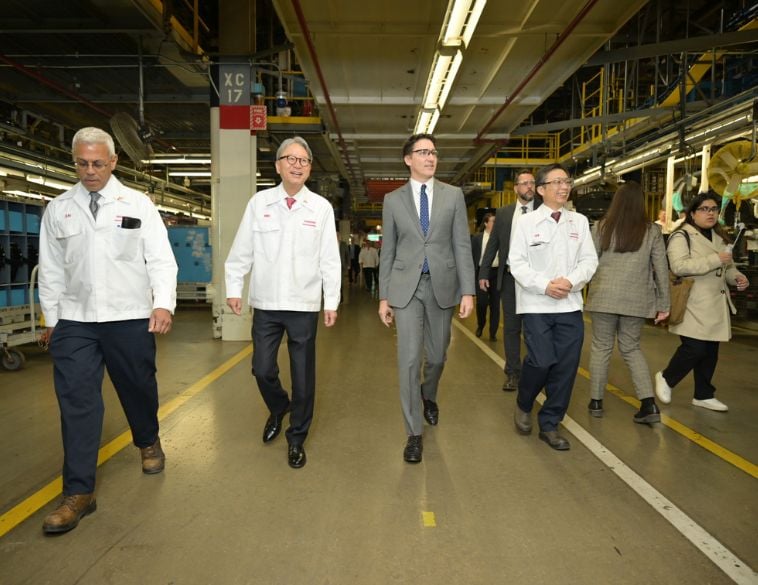Hunter’s integrated Quick Check Drive® and Quick Tread Edge® technology is changing the dynamics of the service drive.
For dealer service departments and independents alike, wheel balancing and alignments are among the biggest profit generators. Yet traditionally, the process of inspection and conversation with the customer can cause friction and considerable inefficiency.
Hunter Engineering Company has been actively looking at ways to improve both efficiency and customer experience in these areas of service operations for both dealership service departments and independent repair centers. Its latest development is the unmanned service inspection process delivered via its Quick Check Drive and Quick Tread Edge systems.
A new level of importance
John Peron, Managing Director, Canada, Hunter Engineering Company, acknowledges that as a result of COVID-19 and heightened awareness around social distancing, the connectivity and integration between Hunter’s Quick Check Drive and Quick Tread Edge systems has gained a new level of importance and relevance for both dealers and independent service providers.
The system, which uses scanners placed in the service drive area (often close to the entrance), allows a customer to drive their vehicle in without stopping until they reach the service kiosk. As the vehicle rolls into the service drive area, the system performs a Touchless Alignment Audit, including Total Toe and Camber, as well as Touchless Tread Depth, assessing all essential parameters of the car without requiring any labour input. The system also communicates available recall information with the inspected vehicle.
Additionally, multiple cameras allow each vehicle to be scanned for body damage, with inspection results displayed instantly on a live Flightboard™ screen.
Easy to understand
By the time the customer reaches the service kiosk to be greeted by the advisor, all the information on their specific vehicle is visible on the screen and is broken down in a way that is simple and easy to understand for both the customer and the advisor.
Peron notes that with the information already visible on the screen, the dynamic of engagement between the customer and service advisor is altered, with the customer often asking questions to the advisor and initiating the conversation. “In most cases, it allows the service advisor to engage from a soft perspective,” he says. The result means that the traditional awkward situation where the service advisor [based on mileage or age of the vehicle] informs the customer the vehicle needs X amount of work and the customer balks, this technology can provide instant inspection feedback based on the current condition of the vehicle. Customers can distinguish between Green, Yellow and Red indicators easily with the visual presentation of the results in Flightboard.
And, because critical items of the vehicle are displayed on a large screen, the service advisor can easily provide a printout of the information, assisting the customer to know exactly what the vehicle needs and why it needs it.
“What we are finding now,” says John Peron, “is that customers are initiating more and more of the conversation such as ‘why is my car showing red in this area, when the other aspects are green?”
Multiple data points
On the tire tread side, multiple data points (approximately 380,000 individual points), allow Quick Tread Edge to generate unique 3D tread patterns – detailed enough to show dirt, mud, stones or wear bars that could be misinterpreted during a typical line scan. By accurately measuring the tire tread depth and identifying edgewear, the system is able to illustrate how a tire that meets all the OE safety requirements performs in terms of stopping distance and how that compares with the actual tires on the vehicle based on their wear and condition.
Additionally, integrated body damage cameras allow the system to take approximately 40 individual photos of each car that comes into the service drive. For dealers, this represents a significant benefit, especially for lease returns and older vehicles, as it allows used car managers to remarket pre-owned vehicles very quickly, ensuring repairs are performed and the vehicles are retailed and turned over rapidly. It also allows service departments and even independent repair facilities to quickly liaise with collision centres and start the estimating process, adding considerable value to the claims process as well as reducing cycle times.
Wider initiative
Quick Check Drive and Quick Tread Edge are leading Hunter’s charge toward a data-driven, connected shop of the future. By connecting autonomous inspection, aligners and balancers to HunterNet, management can accurately track equipment use and efficiency, while identifying trends in shop productivity, and future revenue opportunities.
Content sponsored by Hunter


